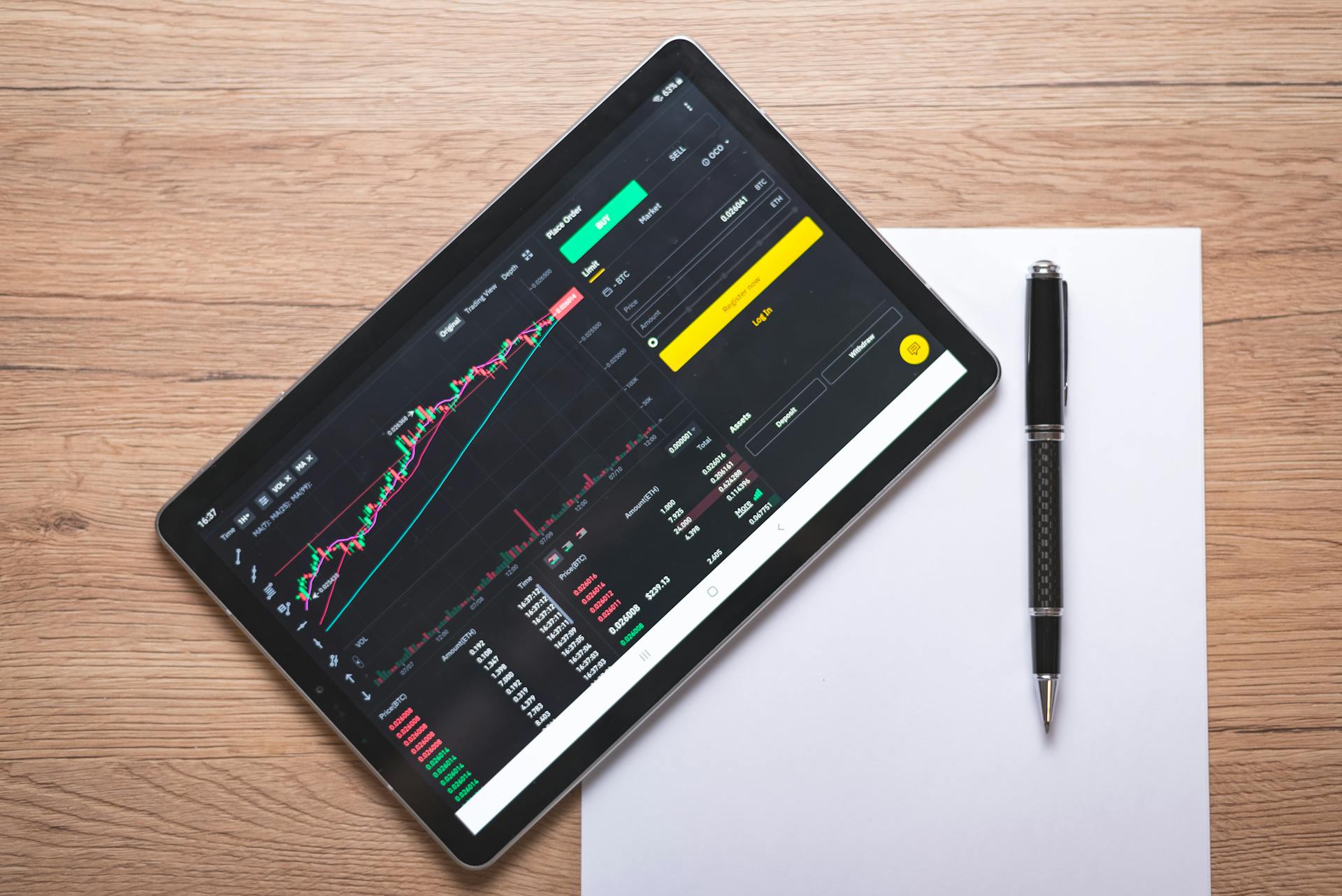
Preferred stock is a type of stock that offers a higher claim on assets and dividends than common stock.
It typically has a higher dividend yield than common stock, which means you can earn more money from it.
Preferred stockholders usually don't have voting rights, but they do get paid dividends before common stockholders.
In exchange for this priority, preferred stockholders typically don't have the same level of control or upside as common stockholders.
What Is Preferred Stock
Preferred stock is a type of investment that offers a unique combination of features. It pays fixed dividends, which can be higher than those offered by common stock, and can be paid monthly or quarterly.
These dividends can be fixed or tied to a benchmark interest rate like LIBOR.
Preferred stockholders have priority over common stockholders when it comes to receiving dividends, which is a big advantage.
Unlike common stockholders, preferred stockholders usually don't have the right to vote.
Preferred stock combines the stability of debt with the potential for appreciation in price, making it appealing to investors seeking stable future cash flows.
Types of Preferred Stock
Preferred stock is a flexible type of security that can be structured in various ways to suit different investors' needs. One type is cumulative preferred stock, where if an issuer misses a dividend payment, the payment is added to the next dividend payment.
Convertible preferred stock, on the other hand, allows shareholders to convert their shares to a predetermined number of common shares. This can be a desirable option for investors who anticipate the company's stock price increasing in the future.
Perpetual preferred stock has no fixed date on which shareholders will receive back their invested capital, giving investors a steady stream of income without the risk of a fixed redemption date.
Exchangeable preferred stock can be exchanged for some other type of security, providing investors with flexibility in their investment portfolio.
Here are some common types of preferred stock:
Convertible preferred stock and participating preferred stock are two of the more frequent types of preferred equity investment structures.
Features and Benefits
Preferred stock offers a unique combination of features and benefits that set it apart from common stock and debt. Here are some key advantages of preferred stock:
Preferred stock holders have priority in claiming a company's assets in the event of liquidation, giving them a more secure position than common shareholders.
Preferred stock often comes with higher dividend payments than common stock, providing a fixed income for investors.
In many cases, preferred stock can be converted to common stock, allowing investors to potentially benefit from long-term growth.
Preferred stock can be repurchased by the issuer at specified dates, giving them flexibility in their capital structure.
Here are some common features of preferred stock:
- Preference in assets upon liquidation
- Dividend payments
- Preference in dividends
- Non-voting
- Convertibility to common stock
- Callability
Issuers of preferred stock can benefit from not having to dilute control, as preferred stock does not provide voting rights or limit existing rights. They also have the flexibility to set up almost any terms for the shares, giving them more control over their capital structure.
Financial Risks and Returns
Losing money on preferred stock is a risk, just like with any other equity investment. You can lose capital invested in the company if it starts to struggle.
Preferred stock may perform differently due to its specific features, but it's still a reflection of the company's performance.
The returns from participating preferred structures can outpace those from convertible preferred investments, but companies often limit the percentage of proceeds that preferred investors can claim.
A 7% preferred stock with a $1,000 par value pays a $70 annual dividend, or $17.50 quarterly, making it attractive to income-generating investors.
The financial sector is the most common issuer of preferred stock, often using it to raise capital.
Investors in preferred stock may see their returns capped to prevent dilution of existing common shareholders' value.
Investment and Market
Preferred stock can be a solid investment option for those seeking regular income and relatively lower risk.
The dividend payments on preferred stock are typically fixed, which can provide a predictable stream of income for investors.
Preferred stockholders usually have a higher claim on assets and earnings than common stockholders, but they usually don't have voting rights.
Investors can choose from various types of preferred stock, including convertible, non-convertible, and redeemable, each with its own characteristics.
Typical Buyers
Individual investors tend to buy preferred stock through online stockbrokers, often combining various features in a way that suits their needs.
Institutions like banks and corporations are the most common buyers of preferred stock, especially during the primary distribution phase, due to tax advantages that individual investors don't have.
Institutional buyers can purchase preferred stock in bulk, making it a relatively simple way for companies to raise large amounts of capital.
Private or pre-public companies issue preferred stock to raise capital, as they can't take on more debt or risk being downgraded.
Established companies like General Electric, Bank of America, and Georgia Power issue preferred stock to finance projects, often because they need to raise capital without taking on more debt.
Snapchat IPO: Non-Voting Shares
In 2017, Snap Inc. made history with its highly anticipated IPO, which consisted of no-vote common shares.
The IPO was structured with three classes of stock: Class A, Class B, and Class C.
Class A shares traded on the NYSE with no voting rights, while Class B shares were reserved for early investors and executives, each with one vote per share.
Class C shares were held exclusively by Snap's two co-founders, CEO Evan Spiegel and CTO Bobby Murphy, who together held 88.5% of Snap's total voting power post-IPO.
The Class C shares came with a whopping ten votes per share, giving the co-founders significant control over the company.
The unique structure of Snap's IPO was met with criticism, as most shareholders were not given voting rights, essentially leaving key decisions up to management.
This move was rare, as Snap's S-1 filing acknowledged that "to our knowledge, no other company has completed an initial public offering of non-voting stock on a US stock exchange."
Examples and Cases
Preferred stock is often issued by financial companies, and banks in particular, to raise capital without giving up voting rights or diluting their common stock.
Banks are the largest issuers of preferred stock, and companies like Allstate Insurance, Goldman Sachs, and AT&T have also issued preferred stock in the past.
Preferred stock can be a good option for investors looking to generate income, as it typically pays a fixed dividend, such as the 7% preferred stock mentioned earlier, which would yield $70 annually or $17.50 quarterly.
Some notable companies that offer preferred stock include Allstate Insurance, Goldman Sachs, AT&T, Bank of America, Wells Fargo, Citigroup, and J.P. Morgan Chase.
Financial companies, including banks, insurance companies, utility companies, and real estate investment trusts (REITs), are the most likely to offer preferred stock.
Key Concepts and Comparison
Preferred stock is a unique type of equity that offers a combination of characteristics from both bonds and common stock, making it an attractive option for certain investors.
Preferred stockholders have a higher claim on distributions, such as dividends, than common stockholders. In the event of a liquidation, preferred stockholders' claim on assets is greater than common stockholders but less than bondholders.
Preferred stock often has characteristics of both bonds and common stock, which enhances its appeal to investors who want recurring cash payouts and less risk than common stock. Preferred stock has no or limited voting rights in corporate governance.
Here's a comparison of preferred stock and bonds:
Preferred stockholders are often behind bondholders during bankruptcy or liquidations, and they have no or limited voting rights in corporate governance. This is a key consideration for investors who want to prioritize their investments.
Perpetual vs Convertible
Perpetual bonds are a type of bond that never matures, meaning investors can hold onto them indefinitely. They typically offer a fixed interest rate.
Perpetual bonds are often used by banks to raise long-term capital, as they provide a stable source of funding. This type of bond is also known as a "perpetual note" or "undated bond".
One key difference between perpetual and convertible bonds is that perpetual bonds do not have a conversion feature, unlike convertible bonds which can be converted into a predetermined number of shares of common stock at a specified price.
Cumulative vs Noncumulative
Cumulative preferred stock requires companies to make up for any missed dividend payments, which accrue to preferred stockholders.
Noncumulative preferred stock, on the other hand, does not require companies to make up any missed dividend payments.
Noncumulative dividends can be missed without penalty, but the company cannot pay a dividend to holders of common stock until it has made holders of its preferred stock whole.
Noncumulative preferreds are typical for bank stocks, while REITs typically issue cumulative preferreds.
Here's a key difference between cumulative and noncumulative preferred stock:
Cumulative preferred stock takes precedence over common stock for receiving dividend payments, meaning that a share of cumulative preferred stock must have all accumulated dividends from all prior years paid before any other lower-tier share can receive dividend payments.
Difference Between Preferred Stock and Shares
Preferred stock and shares are often confused with each other, but they have distinct differences. Preferred stock is a type of equity that represents ownership of a company and the right to claim income from the company's operations.
One key difference between preferred stock and shares is the claim on distributions. Preferred stockholders have a higher claim on distributions than common stockholders, but bondholders have a higher claim than preferred stockholders.
Preferred stock often has characteristics of both bonds and common stock, which can be beneficial to certain investors. However, it also comes with caveats that potential buyers need to be aware of.
Here are some key differences between preferred stock and shares:
In terms of dividend payments, preferred stock can pay a fixed dividend, but may also pay a floating rate that depends on some benchmark interest rate. Unlike debt, payments on preferred stock are not tax-deductible.
Preferred stock may not have a maturity date, and can be issued in perpetuity, meaning it can pay dividends as long as the company is in business. However, this also means that investors may lose their income stream and preferred stock if the company calls back the stock at a lower yield.
Frequently Asked Questions
What is a 5% preferred stock?
A 5% preferred stock is a type of investment that pays a fixed annual cash dividend of $5 for every $100 par value. However, the actual return on investment, or yield, may be different due to the price paid for the stock.
What does 7% preferred stock mean?
7% preferred stock refers to a type of stock that pays a fixed annual dividend of 7% of its par value, typically $1.75 per share for a $25 par value stock
What is the downside of preferred stock?
Preferred stock has two main downsides: it ranks lower in seniority than bondholders in the event of bankruptcy, and it can be less liquid than other investments. This means preferred shareholders may not receive their investment back if the company liquidates.
What does 8% preferred stock mean?
8% preferred stock means you'll receive an 8% yearly dividend on the face value of your investment. This type of equity investment offers a fixed return, but dividend payments may be delayed or skipped by the company
Sources
- https://www.investopedia.com/terms/p/preferredstock.asp
- https://www.law.cornell.edu/wex/preferred_stock
- https://corporatefinanceinstitute.com/resources/career-map/sell-side/capital-markets/preferred-shares/
- https://www.bankrate.com/investing/what-is-preferred-stock/
- https://www.wallstreetprep.com/knowledge/preferred-stock/
- https://www.wallstreetprep.com/knowledge/common-shares-vs-preferred-shares/
Featured Images: pexels.com


